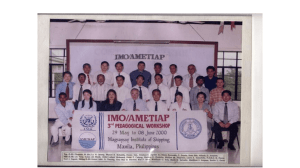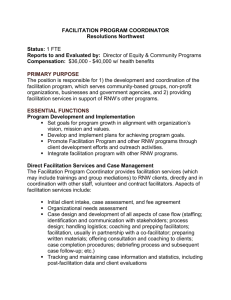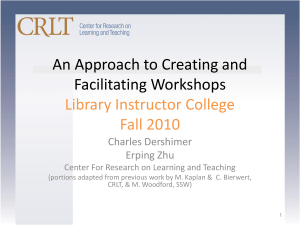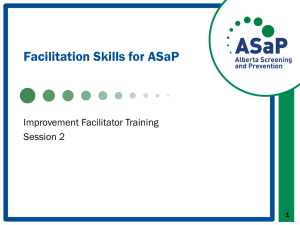Practice Facilitation
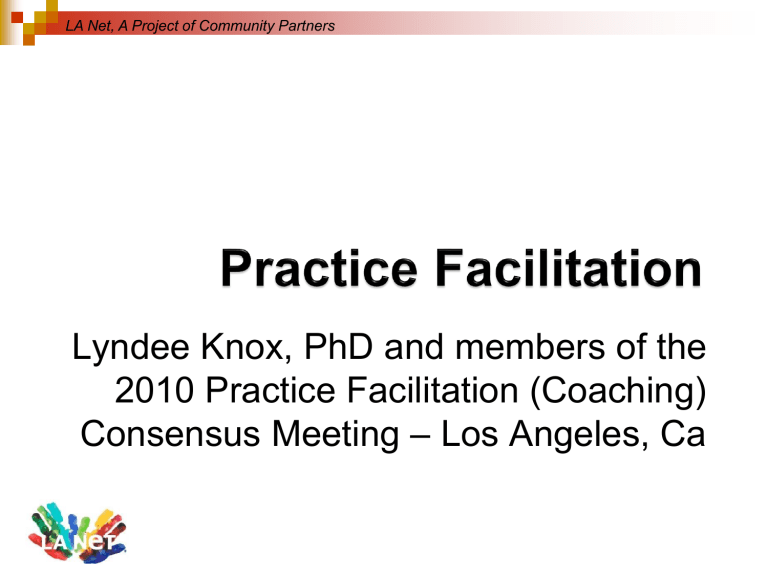
LA Net, A Project of Community Partners
Lyndee Knox, PhD and members of the
2010 Practice Facilitation (Coaching)
Consensus Meeting – Los Angeles, Ca
How do we support quality improvement in the safety net more effectively?
Learning collaboratives have produced positive change; but have not been sufficient to reach desired targets. More Is needed.
Prior project funded by AHRQ to develop a “toolkit” to support practice-led implementation of the Chronic Care
Model (CCM) in the safety net.
Integrating Chronic Care and Business Strategies in the Safety Net. AHRQ
Publication NO. 08-0104-EF. Prepared by: MacColl Institute for Healthcare
Innovation, RAND Health, and the California Health Care Safety Net
Institute. TOO: Cindy Brach
Practices had difficulty implementing on their own, so
AHRQ explored use of Facilitators (PFs), developed preliminary resources for them, and conducted a pilot investigation of their impact.
Integrating Chronic Care and Business Strategies in the Safety Net: A Practice
Coaching Manual. Written by: Coleman, Pearson, Wu 2009; Edited by:
Cindy Brach
Current project is next phase of the ARHQ
CCM in the Safety Net project. It involves: a) consensus meeting (working group) on
PF, and b) implementation and evaluation of a PF intervention in 20 safety net practices.
MAFPRN (Kevin Peterson, Master Contract
Holder), LA Net (Lyndee Knox, PI), AHRQ
TOO (Cindy Brach)
• Practice facilitators are specially trained individuals who assist primary care clinicians in research and quality improvement projects.
• They are distinguished from consultants through specialized training, broad scope of practice, and longterm relationships with an organization, its providers and its patients.
Adrienne Bowes (Redwood)
Brenda Fraser(QIIP)
Carolyn Sheperd (Clinica Campesina)
Cathy Catrambone (Rush)
Chuck Kilo (GreenField Health & OUSU)
Cindy Brach (AHRQ)
Cindy Dickinson (Southwest)
Clare Liddy (Un of Ottawa)
Craig Jones (Vt Blueprint for Health)
Corey Sevin (IHI)
Darren DeWalt (UNC)
Doug Eby (SouthCentral)
Elizabeth Stewart (Un of Texas)
Ellen Christiansen (Coastal Health
Alliance)
Grace Floutsis (Oscar Romero)
James Mold (UOHSC)
John Kotick (FHCCGLA)
June Levine (L.A. Net)
Kate Coleman (MacColl)
Katy Smith (UOHSC)
Kelly Pfeifer (SF Health Plan)
Kevin Peterson (UMN)
Leif Solberg (Health Partners)
Lisa Kodmur (L.A. Care)
Lisa Letourneau (Quality Counts)
Lyndee Knox (L.A. Net)
Mary Ruhe (Rush)
Michael Barr (ACP)
Mike Herndon (OK Healthcare
Authority)
Neil Solomon (Health Net)
Paul Vandeventer (Community
Partners)
Perry Dickinson (U. Colorado)
Roland Palencia (L.A. Care)
Rich Seidman (L.A. Care)
Sophia Chang (CHCF)
Tom Bodenheimer (UCSF)
Trish O’Brien (QIIP)
Veenu Aulakh (CHCF)
•
•
•
•
•
•
•
•
What to call it
The evidence supporting it
Its goals and methods
How to allocate the resource
More and less effective approaches
How to manage a program
Funding and infrastructure needs
Research questions
Decision rules
Name should appeal to customer (the PCP)
Should support scientific publication and development of the field
Should contribute to development of a common vocabulary
Recommendation: Practice Facilitation is: 1) acceptable to PCP; 2) appropriately reflective of activity; and 3) likely to yield scientific publications
Findings are inconsistent and inconclusive at this point
Recent meta analysis (Bakerville, 2009) is encouraging – review of
19 studies showed moderate significant effects for practice behavior change diminishing with complexity of change, and higher facilitator to practice ratios. Link to dissertation available at: www.lanetpbrn.net
NDP study comparing PF to self-directed (Nutting et al, 2010) mixed, showing modest differences between self-directed and
PF pratices in adaptive reserve and proportion of NPD components implemented . Intensity of PF was less than Mold model, primary modality was distal (email/phone/web).
Yet to be published studies show value but also indicate need for additional resources in addition to facilitation to enact and sustain complex change.
Is it the health care system, practice , or the patient ?
Agreement: The primary sphere of influence for PF is the practice
This includes administrative, clinical, QI systems, and a practice’s connections to the outside (other organizations
& community)
Goals of PF are to improve quality, access and improve financial viability at the practice level.
(Triple
Aim).
The issue of cost is particularly important. PF and changes it supports like PCMH will likely increase costs for primary care practices which may reduce financial viability. This is a problem that needs more thought.
Ultimately there should be a business case for change or it will be difficult to sustain.
These were hard to define and are likely project and practice specific.
Some recommended by group:
Create capacity for population management
Create capacity to use data to improve process and quality improvement
Build organizational capacity for change: priority, will, knowledge and ability (Solberg)
Instill hope
There were many others…
PF might support more complex changes:
Electronic visits,
group visits,
team-based care,
wellness promotion, and
Proactive population management
Facilitation is a scarce resource
That should be directed towards practices most likely to benefit (not highly dysfunctional, not exemplars)
That want facilitation
And towards early adopters (most likely to support
“spread” based on Rogers work in diffusion) in the practice community , that can drive “diffusion” of improvements through their practice-based social networks
The Facilitation Ecology
Goals:
Improved patient outcomes
Improved patient experience
Reduced costs
Exemplar practices
Functional practices
Low Functional practices
Survival level practices
Practices that want to engage in improvement Practices that do not
Policy
Payers
Workforce
Health system
Communities
Collaborators
• Approaches:
– Humanistic/self-actualizing --- when org/climate needs
–
–
Facilitation/coordination ---- when knowledge resides in practice
Technical assistance ---when undertaking s/t where know doesn’t reside in practice
• General agreement: Approach should fit: a) needs of practice, and b) goal of the intervention . For interventions where a practice already possess the knowledge (and skills) needed to implement the target improvement, the most appropriate PF approach may be facilitation/coordination to assist the practice to utilize/actualize this existing knowledge/skill. For interventions where a practice does not already possess the knowledge/skill , then the most appropriate PF approach may be to provide/broker deep technical assistance on the topic. Most PF interventions are likely to require a combination of the three approaches .
• The goodness of fit between PF approach, practice need, and improvement goals is an important factor in determining the eventual effectiveness of the PF interventio n. The lack of a good fit between approach and the needs of the practice and the improvement goals can contribute to general dissatisfaction with the PF encounter.
•
Determining “practice readiness” is a critical first step to the process
• Some readiness criteria:
– Support of leadership
–
–
–
Change is a priority
Basic functionality across most organizational systems
Sufficient “adaptive reserve” to make the changes (e.g. the time, money, people, they need to make desired changes)
–
–
In vivo demonstration of willingness and ability to engage in a change process
They do not have “change fatigue” – which may become increasingly common in coming years with reform underway.
This concept needs additional consideration.
References: Some tools for assessing practice readiness for facilitation
Organizational Readiness for Change (ORC)
Lehman, W.E.K, JM Greener, DD Simpson. (2002). Assessing
Organizational Readiness for Change. Journal of Substance Abuse
Treatment 22: 197-209.
Learning Teams for Reflective Adaptation (ULTRA) readiness survey
Ohman-Strickland, PA et al. (2006). Measuring organizational attributes of
Primary Care Practices: Development of a New Instrument. Health
Research and Educational Trust 42 (3): 1257-1273.
Predicting Outcomes of Org Change Survey
Gustafson DH, Sainfort F, Eichler M, Nutting PA, Dickinson WP, et al.
Developing and testing a model to predict outcomes of organizational change. Health Services Research (2003) 38 (2): 751-776.
Location of facilitators:
Internal
External
Embedded or hybrid
General agreement: Internal is ineffective . Internal “facilitators” get pulled away from facilitation role by competing demands, and often lack the distance they need to drive change. Possible exception to this is IPA or other type organization, where facilitator is internal to organization but not to individual practice. Hybrid and external models are preferred.
Embedded or hybrid may be most effective .
• Type of facilitator
– Generalist (facilitative and QI skills)
–
–
Specialist (expert knowledge in particular area: e.g. billing)
Team (multiple persons led by generalist)
• General agreement: Team facilitation approach is preferable. It may also be more expensive.
•
The team consists of a “generalist facilitator” who commands core skills in facilitation, QI and essential technical elements, and then manages a “team” of “specialist” facilitators that he/she brings in based on specific needs of practice.
Modalities:
In person
Email and phone and web
Combination
No clear agreement here: Trend towards predominately in-person being more effective.
But what constitutes a good mix is not clear yet and may be practice specific.
Use of IT in PF has been limited mainly to a strategy for reducing costs of PF. Its use to increase the impact of PF needs consideration.
Average interventions range from 100-200 contact hours, with a minimum dose of 120 hours.
Not enough information yet to suggest what constitutes a sufficient dosage of PF. This may be difficult to tease out but it important to know b/c of implications for cost and design. Prevention and intervention science in behavioral health has had success in developing some guidelines on interaction “dosage” based on 20-30 years of research.
Will likely vary on the type and magnitude of change being sought. And the particular traits of the practice.
• Schedule for facilitation
–
–
Intensive: All day, everyday for 4 wks w/ follow-up
Consistent: Weekly for ½ for 10 months or more
–
–
Intermittent: PRN
Combination of the above
• No clear preference for schedule emerged in discussion. Depends on factors such as project goals, funding structure and timeline, PF staffing model, budget.
PF can be provided:
As a stand alone intervention
In combination with other approaches
w/ traditional learning collaborative as a primary or secondary intervention
w/ academic detailing (peer to peer influence/learning)
w/ local learning collaboratives
General agreement: PF should be provided in combination with other resources and approaches including collaboratives and also payment reform.
No clear agreement on PF and collaborative combination designs. Some suggest collaboratives are best for providing tools and peer pressure/external motivation. PF provides the ability to tailor the information to the needs of the site, give deep technical support and directly facilitate change at practice level.
Variations in the way a practice makes money (fee for service, capitated), is organized (CHC, other staff model, small or group independent), is staffed (MD, MD-mid-level), and size (small, large):
Affect motivation for improvement, the drivers for improvement, feasibility and resources available to support improvement, improvement goals , and the business case for improvement
While PF skills used across practices remain consistent, these variations have implications for scope of PF knowledge, PF goals and strategies.
•
•
•
•
•
•
•
Infrastructure needs
Hiring issues
Training & supervision of PFs
Recruiting practices for facilitation
Cost
Sources of funding
Evaluating your services
•
•
•
•
•
• PBRNs and university research programs
QI organizations
State Health Departments
HIT Regional Extension Centers
Trusted intermediaries such as clinical associations
National Health Service (Canada)
Proposed: National Primary Care Extension Service
Divided on issue of clinical experience :
Some say PF must have clinical experience to be able to provide relevant assistance.
Others say not essential (esp. w/ team coaching approach)
can gain this type of knowledge on the job
say clinical experience can be a detriment by introducing historic turf/power issues, limiting PF’s perspective/options considered
Some say most important to have very good interpersonal and facilitative skills
Others say technical expertise is more important than any of the above: how to do panel management, implement group visits, practice redesign – the “nuts and bolts”
Both consultant and employee models are used
No clear agreement: Employee model may be more effective for ensuring fidelity to a particular model. But consultants may do this equally well. May be person dependent.
•
•
•
•
Communication and interpersonal skills
General facilitative skills
Specific QI skills
Select deep technical skills in specific high need/yield areas
(not yet defined)
Two core competencies resource documents:
AHRQ Consensus Group. 2010. Working Draft: Core competencies for generalist coaches. Available online at: www.lanetpbrn.net
Fraiser, B. 2009. Quality Improvement Coach Competencies.
Available online at: www.lanetpbrn.net
• Most common approach is through intensive workshop , combined with on-going supervision
• Internship in clinical environment not necessary , gain this on the job in first 4 weeks.
Training resources for facilitators
–
–
–
–
–
PEA training manual (Jim Mold)
IPIP training materials (Darren deWalt – not ready yet)
Impact BC training materials (http://www.impactbc.ca/)
IHI’s newly launched PC series (Corey Sevin – first session July)
Small practice eDesign (Sophia Chang, CHCFoundation – not ready yet)
–
–
Improving Chronic Care Practice Coaching Manual
Dartmouth Coach (Margie Godfrey, not ready yet, http://dms.dartmouth.edu
A complete list is available at: www.lanetpbrn.net
General agreement: The work of Facilitators is challenging and at times taxing, requires intensive interpersonal work, and can involve the sometimes difficult work of a non-MD establishing credibility with an MD.
As such, PFs need strong support systems at the home office in the form of supervision, learning communities with other PFs, and social/emotional support.
General agreement: Weekly PF supervision, learning and support sessions are essential for on-going professional development, emotional support and idea exchange
•
Addressing practice’s concerns about being overwhelmed by other projects/activities
•
• PF as organizer across change initiatives
PF as resource to develop comprehensive improvement
“plan” for practice that weaves together and leverages across on-going projects
•
Identifying and using PF to respond to practice’s internal and external improvement pressures and goals
• Must ultimately improve finances and/or life of PCPs and staff to be viable long term
Costs for practice facilitation can range from $10,000 to
$45,000 per practice for average 120-200 hour intervention. Depending on PF staffing model, goals, intensity.
• Mainly short-term and project limited funds:
– Grants (for research)
– QI contracts from payers
– By clinics
– HIT REC centers (possible source)
• This may change through proposed Primary Care
Extension Program (Mold)
Recurring theme: Financial impact and PF
PF can support some useful changes in the present environment
But buy-in, impact and also uptake of improvements by PCPs may be limited
Until a practice sees clear financial and life quality benefits for improving care and outcomes
• Disseminate summary report
– Wiki for collective additions to report
•
Prepare curriculum and facilitator “toolkit” (to complement
CCM Toolkit already developed by AHRQ)
– Wiki for collective additions to both
• Evaluate PF intervention to increase implementation of
Chronic Care Model in 20 safety net practices in LA
Join our practice coaching listserv. To join, email: maryam.komaie@gmail.com




